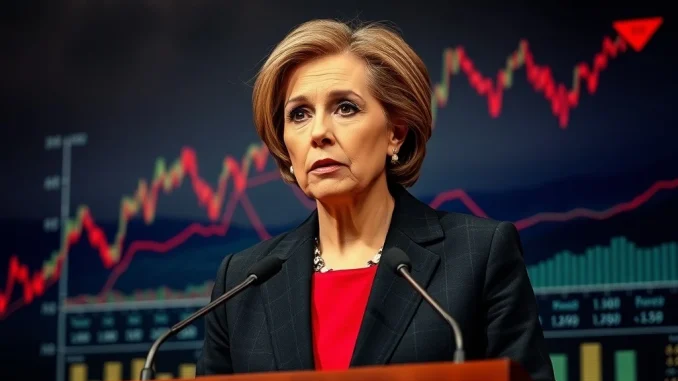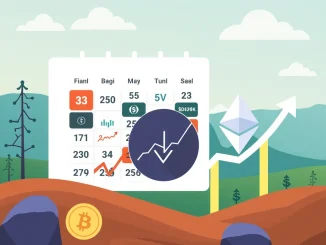
In the volatile world of cryptocurrencies, understanding the broader macroeconomic landscape is paramount. Decisions made by central banks, particularly the U.S. Federal Reserve, ripple through every asset class, including Bitcoin and altcoins. Recently, U.S. Federal Reserve Governor Adriana Kugler delivered a significant message that could shape market sentiment: Fed rate cuts are currently not appropriate, primarily due to the widening influence of tariffs. This stance underscores the Fed’s commitment to combating inflation, even if it means maintaining a tighter monetary grip for longer.
Why Are Fed Rate Cuts on Hold? Governor Kugler’s Insight
During a recent speech, Federal Reserve Governor Adriana Kugler made it clear that, in her view, lowering interest rates at this juncture would be premature. Her assessment, as reported by Odaily, points to a crucial factor: the tariff impact. Kugler emphasized that the effects of these trade barriers are beginning to spread more broadly across the economy. This spreading impact necessitates a continued focus on tightening monetary policy to ensure that inflation expectations remain anchored.
This perspective highlights the complex balancing act the Fed faces. While some sectors of the economy might benefit from lower borrowing costs, the overriding concern is price stability. The Fed’s dual mandate includes maximizing employment and maintaining stable prices. Kugler’s remarks indicate that the latter is currently taking precedence, especially when new inflationary pressures, like those stemming from tariffs, emerge.
Understanding the Spreading Tariff Impact on the Economy
When we talk about the tariff impact, it’s not just about goods getting more expensive at the border. Tariffs, essentially taxes on imported goods, have a cascading effect throughout the economy:
- Increased Input Costs: Businesses that rely on imported raw materials or components face higher costs. These costs are often passed on to consumers in the form of higher prices for finished goods.
- Supply Chain Disruptions: Tariffs can force companies to seek alternative, potentially more expensive, suppliers or reconfigure their supply chains, leading to inefficiencies and further cost increases.
- Reduced Trade Volume: Higher tariffs can reduce the overall volume of international trade, impacting economic growth and potentially leading to job losses in export-oriented industries.
- Uncertainty: The imposition and threat of tariffs create economic uncertainty, which can deter business investment and consumer spending.
Governor Kugler’s concern is that this ripple effect is becoming more pervasive, potentially reigniting inflationary pressures even as other economic indicators might suggest a cooling trend.
The Critical Role of Monetary Policy in Taming Inflation Expectations
At the heart of Governor Kugler’s statement is the need for continued tightening of monetary policy. But what exactly does this mean, and why is it so vital?
Tightening monetary policy refers to actions taken by a central bank to reduce the money supply and credit availability in an economy. The primary tool for this is raising interest rates, which makes borrowing more expensive and encourages saving. This slows down economic activity, cooling demand and, in theory, bringing down inflation.
The Fed’s focus on controlling inflation expectations is key. If consumers and businesses expect prices to continue rising significantly, they may adjust their behavior (e.g., demanding higher wages, raising prices) in a way that creates a self-fulfilling prophecy of persistent inflation. By maintaining a firm stance, the Fed aims to signal its unwavering commitment to bringing inflation back to its target, thereby managing these expectations.
Who is Adriana Kugler and Why Does Her Stance Matter?
Adriana Kugler is a distinguished economist and a member of the Federal Reserve’s Board of Governors. Appointed in 2022, she brings extensive experience in labor economics and public policy to her role. As one of the seven governors, her voice carries significant weight in shaping the Fed’s monetary policy decisions. The Board of Governors, along with presidents of some Federal Reserve Banks, forms the Federal Open Market Committee (FOMC), which sets the federal funds rate.
Her statements provide valuable insight into the thinking within the Fed, offering clues about future interest rate decisions. For investors, including those in the cryptocurrency space, understanding the nuances of a Fed Governor’s perspective can help anticipate market movements and adjust strategies accordingly. Her focus on tariffs as an inflationary factor adds a new dimension to the Fed’s current economic assessment.
Navigating the Economic Landscape: Challenges and Outlook
The current economic environment is a delicate balance. While the U.S. economy has shown resilience, persistent inflation remains a concern. The decision to hold off on Fed rate cuts, influenced by the spreading tariff impact, highlights the ongoing challenges.
Maintaining higher interest rates for longer can:
- Increase Borrowing Costs: For consumers with variable-rate loans and businesses looking to expand, higher rates mean increased financial burdens.
- Slow Economic Growth: While necessary to curb inflation, a prolonged period of tight monetary policy can dampen overall economic activity, potentially leading to slower job growth or even recession.
- Impact Asset Valuations: Higher rates generally make riskier assets, like cryptocurrencies, less attractive compared to safer, yield-bearing investments. This can contribute to downward pressure on crypto prices.
However, the benefit of this cautious approach is the potential for long-term price stability. By proactively addressing new inflationary pressures, the Fed aims to create a more predictable economic environment, which is ultimately beneficial for all market participants.
In conclusion, Fed Governor Adriana Kugler’s recent comments underscore the Federal Reserve’s unwavering commitment to controlling inflation, even in the face of evolving economic challenges like the spreading tariff impact. Her clear signal that Fed rate cuts are not appropriate for now reinforces the central bank’s focus on maintaining a tight monetary policy to manage inflation expectations. For the cryptocurrency market, this means continued vigilance on macroeconomic indicators, as central bank decisions will undoubtedly remain a dominant force influencing market trends.
Frequently Asked Questions (FAQs)
Q1: What are Fed rate cuts and why are they significant?
Fed rate cuts refer to the Federal Reserve lowering its benchmark interest rate, the federal funds rate. This makes borrowing cheaper for banks, which in turn lowers interest rates for consumers and businesses. Rate cuts are significant because they stimulate economic activity by encouraging spending and investment. They can also make riskier assets, like cryptocurrencies, more attractive as the cost of capital decreases.
Q2: How do tariffs influence inflation?
Tariffs are taxes on imported goods. They can influence inflation by increasing the cost of these goods for domestic consumers and businesses. When businesses face higher costs for imported materials or components due to tariffs, they often pass these costs on to consumers through higher prices for their products, contributing to overall inflation.
Q3: What is “tightening monetary policy”?
Tightening monetary policy is a strategy employed by central banks, like the Federal Reserve, to reduce the money supply and curb inflation. This is typically achieved by raising interest rates, which makes borrowing more expensive and encourages saving, thereby slowing down economic growth and cooling inflationary pressures.
Q4: Why are inflation expectations important to the Federal Reserve?
Inflation expectations are crucial because they can become a self-fulfilling prophecy. If people expect prices to rise significantly in the future, they might demand higher wages or raise their own prices, leading to a cycle of escalating inflation. The Federal Reserve aims to manage these expectations by demonstrating its commitment to price stability, thereby preventing a persistent inflationary spiral.
Q5: How do Fed decisions, like holding off on rate cuts, affect cryptocurrency?
Fed decisions have a significant indirect impact on cryptocurrency. When the Fed holds off on rate cuts, it generally means interest rates remain higher. Higher interest rates can make traditional, less volatile investments (like bonds or savings accounts) more attractive, potentially drawing capital away from riskier assets like cryptocurrencies. It also increases the cost of borrowing for crypto investors and businesses, which can dampen market activity and investment.
Q6: Who is Adriana Kugler within the Federal Reserve system?
Adriana Kugler is a Governor on the Board of Governors of the Federal Reserve System. As one of the seven governors, she is a key decision-maker on the Federal Open Market Committee (FOMC), which is responsible for setting the nation’s monetary policy, including interest rates. Her views and statements offer important insights into the Fed’s current economic outlook and policy direction.



